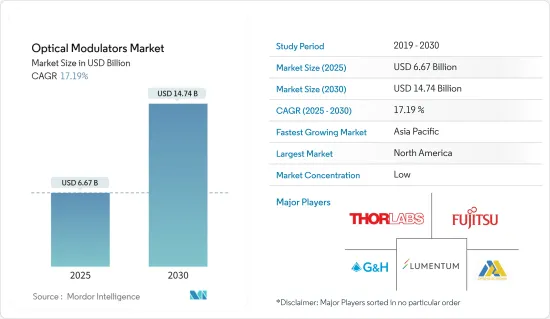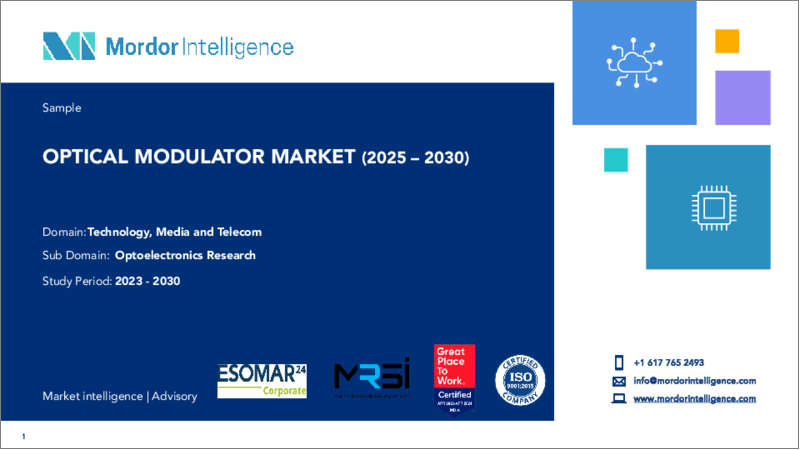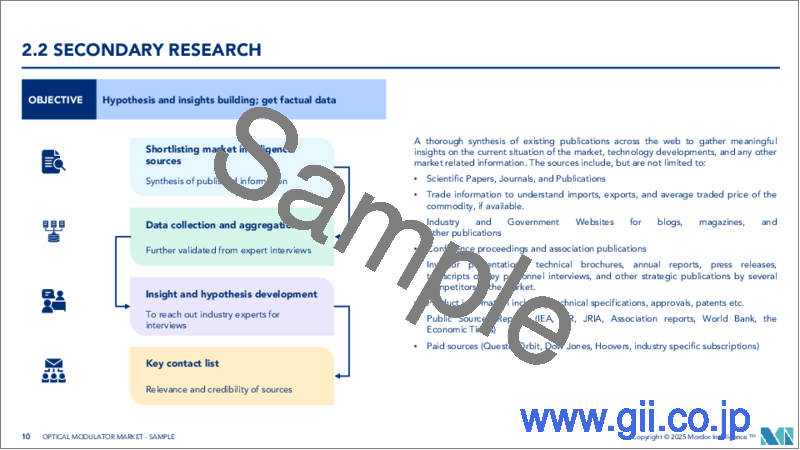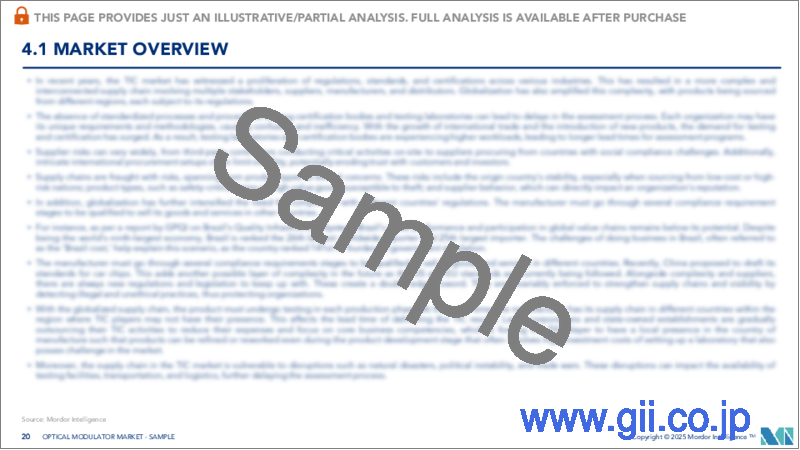|
|
市場調査レポート
商品コード
1687949
光変調器:市場シェア分析、産業動向・統計、成長予測(2025年~2030年)Optical Modulators - Market Share Analysis, Industry Trends & Statistics, Growth Forecasts (2025 - 2030) |
||||||
カスタマイズ可能
適宜更新あり
|
|||||||
| 光変調器:市場シェア分析、産業動向・統計、成長予測(2025年~2030年) |
|
出版日: 2025年03月18日
発行: Mordor Intelligence
ページ情報: 英文 128 Pages
納期: 2~3営業日
|
全表示
- 概要
- 目次
光変調器の市場規模は2025年に66億7,000万米ドル、2030年には147億4,000万米ドルに達すると予測、予測期間(2025-2030年)のCAGRは17.19%です。

主なハイライト
- 光変調器は、光ファイバネットワークで重要な役割を果たしています。トランジスタは、電子信号のスイッチとして機能します。同様に、光変調器は光信号のスイッチとして機能します。光通信は主に光を使用するため、光変調器の機能は、光ファイバー上に2値信号のストリームを送る光をオン・オフすることです。
- ソーシャルメディア・プラットフォーム、eコマース、ソフトウェアの利用が大幅に増加したことで、データ需要が大幅に加速しました。5Gは、エンドユーザーがより多くのデータを消費し、生成するための新たな道を開いた。例えば、GSMAによると、2025年までに5Gネットワークは世界人口の3分の1をカバーするようになるといいます。同協会はまた、5Gの接続数は2025年までに20億を超え、モバイル接続の5分の1以上を占めると述べています。
- ビデオストリーミング、クラウドコンピューティング、モノのインターネット(IoT)などの要因によってデータトランスミッションの需要が増え続けているため、通信ネットワークではより高い帯域幅が必要とされています。光ファイバーは従来の銅線ケーブルに比べて高い帯域幅を提供するため、長距離データ・トランスミッションには光ファイバーが選ばれるようになりました。そのため、電気信号を広帯域の光信号に効率よく変換する光変調器のニーズが高まっています。
- さまざまなビジネス機能やワークロードを管理するため、独自のハイパースケールデータセンターを取得する企業や事業者が増えています。生成されるデータの急速な増加に伴い、データセンターの規模を拡大する必要性が高まっています。データセンターの設計と管理に対する最新のアプローチであるデータセンター・ディスアグリゲーションは、データセンターのさまざまなコンポーネントを個別のユニットに分離するもので、効果的なソリューションとなり得る。このアプローチにより、柔軟性、拡張性、エネルギー効率の向上、コスト削減が可能になります。
- 光インターコネクトは、データセンターの分離を可能にする重要な技術であり、光ファイバーケーブルを使って長距離を高速でデータ伝送します。この技術は、高い帯域幅容量と低い消費電力により、データセンターの分散アプリケーションに適しています。このような相互接続ソリューションでは光変調が重要な機能であるため、光変調器の採用が進んでいます。しかし、光変調器は光相互接続に使用される主要コンポーネントの1つであり、その商品化の遅れや性能、コスト、効率のバランスが市場の成長を妨げる大きな課題の1つとなっています。
- COVID-19パンデミックの間、リモートワーク、オンライン学習、eコマースの利用増加へのシフトがインターネットトラフィックを促進し、光変調器の需要を牽引したため、帯域幅の広い通信ネットワークへの需要が大幅に増加しました。また、パンデミックはクラウドベースのサービスの採用を加速させ、堅牢なデータセンターインフラと高速光相互接続を必要としました。
光変調器市場動向
光通信が大きな市場シェアを占める見込み
- 光通信とは、電流の代わりに光を使って信号を遠隔地に伝送する通信のことです。光通信は、信号を目的地に運ぶために光ファイバーに依存しています。変調器/復調器、送受信器、光信号、透明チャネルが光通信システムの構成要素です。
- 帯域幅と通信サービスの需要は過去10年間で急増し、光ファイバー通信システムにおける外部変調の必要性が高まっています。特に、ニオブ酸リチウム(LiNbO3)外部変調器の統合は、所望の帯域幅だけでなく、分散効果を最小化する手段も提供する適切なソリューションとして発展しています。
- レーザーダイオードの直接変調と比較して、LiNbO3ガイド波変調器は、ゼロチャープまたは調整可能なチャープ動作用に設計することができ、ファイバー分散に関連するシステム劣化を最小限に抑えるのに役立ちます。アナログシステムでは、線形化された外部変調器が非常に低い変調歪みを提供できます。
- 光ファイバーの需要は経済開発にとって不可欠であり、技術革新と経済成長のペースを向上させるために必要な帯域幅の進歩をサポートするために、ファイバー密度を高める必要があります。その一例が5Gの進歩であり、高速無線周波数とネットワークの高密度化への依存です。従って、このような要因が光ファイバーインフラへの投資需要を促進しています。
- 2023年7月、インド電子情報技術省は、接続性を強化し、すべての人に安価なインターネットを提供するため、インド全土にファイバーグリッドを確立するために、従来の83億米ドルに130億米ドルを追加投資する計画を発表しました。このような光通信関連投資の増加は、光変調器ニーズを促進すると見られています。
北米が最大の市場シェアを占める見込み
- この地域の市場は、高帯域幅と高データレートのアプリケーションに対する需要の高まり、電子機器の小型化要求、インターネット普及率の上昇、5Gインフラの迅速な開拓によって大きな影響を受けると予想されます。
- この地域の通信産業における光ファイバの広範な使用は、より高い性能と速度に対する需要の高まりによって後押しされており、光技術の有望な将来を予感させる。広範な研究活動が継続され、実用的な展開に拡大されるにつれて、新世代の光ファイバー通信につながると予想されます。
- データセンターやハイパフォーマンスコンピューティング(HPC)アプリケーションで光通信システムの利用が拡大していることも、市場を牽引する要因の1つです。高い帯域幅とデータレートが要求されるため、データセンタとハイパフォーマンスコンピューティングアプリケーションが光変調器需要を牽引すると予測されています。さらに、データセンタやHPCアプリケーションの建設投資の増加により、光変調器の需要はこの地域で大幅に増加すると予測されています。
- 北米地域では、クラウドベースの企業アプリケーションが盛んです。クラウドベースのソリューションは、ホスト環境で機能するためにインターネット接続に依存しています。5Gはより高速なインターネット速度を可能にするため、接続エクスペリエンスはさらに向上すると思われます。さらに、ビッグデータ分析やクラウド・コンピューティングの増加に伴うモバイル・ブロードバンドの急成長は、北米における新たなデータセンター・インフラの需要を促進しています。クラウドベースのデータセンターへの急速な投資は、光変調器メーカーにいくつかの応用機会を提供すると期待されています。
光変調器市場概要
光変調器市場は、世界プレーヤーと中小企業の両方が存在するため断片化されています。市場の主要企業は、Thorlabs Inc.、Lumentum Holdings Inc.、AA Opto-Electronic、Fujitsu Optical Components Limited、Gooch &Housego PLCです。同市場のプレーヤーは、持続可能な競争優位性と市場シェアを獲得するために、パートナーシップ、コラボレーション、M&A、製品投入などの戦略を採用しています。
- 2024年5月光通信技術企業のLightwave Logicは、Advanced Micro Foundry(AMF)と提携し、AMFのシリコンフォトニクスプラットフォームを利用したポリマースロットモジュレータを開発しました。両社の合意は、前年にAMFの200mmウェハーの標準製造プロセスフローを利用した電気光学ポリマースロットモジュレーターの開発で提携したことによる。
- 2024年3月:集積型電気光学変調器(EOM)のプロバイダーであるHyperLight社は、強度変調器シリーズを拡充しました。この発表は、フォトニクス集積回路(PIC)の革新に対するHyperLightの継続的なコミットメントを強調するものです。同社が提供する変調器は、独自の高帯域幅・低電圧ニオブ酸リチウム薄膜(TFLN)PIC技術に基づいています。
その他の特典:
- エクセル形式の市場予測(ME)シート
- 3ヶ月間のアナリスト・サポート
目次
第1章 イントロダクション
- 調査の前提条件と市場定義
- 調査範囲
第2章 調査手法
第3章 エグゼクティブサマリー
第4章 市場洞察
- 市場概要
- 業界の魅力度-ポーターのファイブフォース分析
- 供給企業の交渉力
- 消費者の交渉力
- 新規参入業者の脅威
- 代替品の脅威
- 競争企業間の敵対関係の強さ
- COVID-19の市場への影響
第5章 市場力学
- 市場促進要因
- 光ファイバー通信インフラへの投資の増加
- 市場の課題
- 光変調器の設計制約が市場成長に影響
第6章 市場セグメンテーション
- タイプ別
- 振幅変調器
- 偏光変調器
- 位相変調器
- アナログ変調器
- その他の光変調器
- 用途別
- 光通信
- 光ファイバーセンサー
- 宇宙・防衛
- 産業用システム
- 地域別
- 北米
- 欧州
- アジア
- オーストラリア・ニュージーランド
- ラテンアメリカ
- 中東・アフリカ
第7章 競合情勢
- 企業プロファイル
- Thorlabs Inc.
- Lumentum Holdings Inc.
- AA Opto-Electronic
- Fujitsu Optical Components Limited
- Gooch & Housego PLC
- Lightwave Logic
- Hamamatsu Photonics KK
- APE GmbH
- Conoptics Inc.
- L3Harris Technologies Inc.
- AMS Technologies AG
第8章 投資分析
第9章 市場の将来
The Optical Modulators Market size is estimated at USD 6.67 billion in 2025, and is expected to reach USD 14.74 billion by 2030, at a CAGR of 17.19% during the forecast period (2025-2030).

Key Highlights
- The optical modulator plays an essential role in fiber-optic networks. A transistor acts as a switch for electronic signals; likewise, an optical modulator acts as a switch for optical signals. Optical communication primarily uses light, so the modulator's function is to turn the light that sends a stream of binary signals over optical fibers on and off.
- The significant rise in the use of social media platforms, e-commerce, and software has accelerated data demand significantly. 5G has opened new avenues for end users to consume and generate more data. For instance, according to the GSMA, by 2025, 5G networks will cover one-third of the world's population. The association also stated that the number of 5G connections would exceed 2 billion by 2025, making up more than a fifth of mobile connections.
- The ever-increasing demand for data transmission, driven by factors like video streaming, cloud computing, and the Internet of Things (IoT), necessitates higher bandwidths in communication networks. As optical fibers provide higher bandwidth compared to traditional copper cables, they become the preferred choice for long-distance data transmission. Thus, the need for optical modulators is growing as they offer an efficient transition of electrical signals into high-bandwidth optical signals.
- An increasing number of businesses and enterprises are acquiring their own hyperscale data centers to manage different business functions and workloads. With the rapid growth in data generated, there is a significant need for data centers to scale up. Datacenter disaggregation, which is a modern approach to data center design and management that separates the different components of a data center into distinct units, can be an effective solution. The approach allows greater flexibility, scalability, and improved energy efficiency and cost savings.
- Optical interconnects are the key technology that enables data center disaggregation and uses fiber optic cables to transmit data at high speeds over long distances. This technology is well-suited for disaggregated data center applications due to its high bandwidth capacity and low power consumption. As optical modulation is the key functionality in such interconnect solutions, it drives the adoption of optical modulators. However, optical modulators are one of the primary components used in optical interconnection, and their slow commercialization and balancing performance, cost, and efficiency are some of the major challenges hampering the market's growth.
- During the COVID-19 pandemic, the demand for increased bandwidth communication networks increased significantly owing to the shift toward remote work, online learning, and increased use of e-commerce that propelled internet traffic, driving the demand for optical modulators. Also, the pandemic accelerated the adoption of cloud-based services, requiring robust data center infrastructure and high-speed optical interconnects, potentially benefiting the market for data center-specific modulators.
Optical Modulators Market Trends
Optical Communication is Expected to Hold a Significant Market Share
- Optical communication is any type of communication in which light is used to carry the signal to the remote end instead of an electrical current. Optical communication relies on optical fibers to carry signals to their destinations. A modulator/demodulator, a transmitter/receiver, a light signal, and a transparent channel are the building blocks of the optical communications system.
- The demand for bandwidth and telecommunication services has surged over the past decade, which has boosted the requirement for external modulation in fiber-optic communication systems. Notably, integrating lithium niobate (LiNbO3) external modulators is evolving as a suitable solution that offers not just the desired bandwidth but also the means for minimizing dispersion effects.
- Compared to direct modulation of a laser diode, LiNbO3-guided wave modulators can be designed for zero-chirp or adjustable-chirp operation that aids in minimizing the system degradation associated with fiber dispersion. In analog systems, linearized external modulators can provide very low modulation distortion.
- The demand for optical fiber is imperative for economic development, and there is a need for increased fiber density to support the advancements in bandwidth that are necessary to improve the pace of innovation and economic growth. One such example is the advancements in 5G and its dependency on high-speed radio frequency and greater network densification. Thus, such factors are driving the demand for investments in optical fiber infrastructure.
- In July 2023, the Ministry of Electronics and Information Technology India announced its plan to invest an additional USD 13 billion to the prior investment of USD 8.3 billion in the establishment of a fiber grid across India to enhance connectivity and provide affordable internet to all. Such an increase in the investments related to optical communication is expected to drive the need for optical modulators.
North America is Expected to Hold the Largest Market Share
- The region's market is anticipated to be significantly impacted by the rising demand for high bandwidth and high data rate applications, the requirement for electronic device miniaturization, rising internet penetration, and the quick development of 5G infrastructure.
- The widespread use of optical fibers in the region's communications industry is boosted by the growing demand for higher performance and speed, portending a promising future for optical technology. This is anticipated to lead to a new generation of fiber optic communications as extensive research activities continue and are extended to practical deployment.
- The growing use of optical communication systems in data centers and high-performance computing (HPC) applications is another factor driving the market. Due to their high bandwidth and data rate requirements, data centers and high-performance computing applications are predicted to drive the demand for optical modulators. Additionally, the demand for optical modulators is anticipated to increase significantly in the area due to rising investments in constructing data centers and HPC applications.
- Cloud-based enterprise applications are thriving in the North American region. Cloud-based solutions depend on internet connectivity to function in the hosted environment. With 5G enabling much faster internet speed, it will further enhance the connectivity experience. Furthermore, the rapid growth of mobile broadband with an increase in big data analytics and cloud computing drives the demand for new data center infrastructures in North America. The rapid investments in cloud-based data centers are expected to provide several application opportunities for optical modulator makers.
Optical Modulators Market Overview
The optical modulators market is fragmented due to the presence of both global players and small and medium-sized enterprises. The major players in the market are Thorlabs Inc., Lumentum Holdings Inc., AA Opto-Electronic, Fujitsu Optical Components Limited, and Gooch & Housego PLC. Players in the market are adopting strategies such as partnerships, collaboration, mergers & acquisitions, and product launches to gain sustainable competitive advantage and market share.
- May 2024: Optical communications technology company Lightwave Logic collaborated with Advanced Micro Foundry (AMF) to develop polymer slot modulators utilizing AMF's silicon photonics platform. The agreement between the two companies came amid a collaboration in the previous year in which they teamed to develop electro-optic polymer slot modulators using AMF's standard manufacturing process flow on 200-mm wafers.
- March 2024: HyperLight, the provider of integrated electro-optical modulators (EOMs), expanded its intensity modulator series. This announcement underscored HyperLight's continued commitment to the innovation of photonics integrated circuits (PICs). The modulators offered by the company are based on proprietary high-bandwidth and low-voltage thin film lithium niobate (TFLN) PIC technology.
Additional Benefits:
- The market estimate (ME) sheet in Excel format
- 3 months of analyst support
TABLE OF CONTENTS
1 INTRODUCTION
- 1.1 Study Assumptions and Market Definition
- 1.2 Scope of the Study
2 RESEARCH METHODOLOGY
3 EXECUTIVE SUMMARY
4 MARKET INSIGHTS
- 4.1 Market Overview
- 4.2 Industry Attractiveness - Porter's Five Forces Analysis
- 4.2.1 Bargaining Power of Suppliers
- 4.2.2 Bargaining Power of Consumers
- 4.2.3 Threat of New Entrants
- 4.2.4 Threat of Substitute Products
- 4.2.5 Intensity of Competitive Rivalry
- 4.3 Impact of COVID-19 on the Market
5 MARKET DYNAMICS
- 5.1 Market Drivers
- 5.1.1 Increasing Investments in Optical Fiber Communication Infrastructure
- 5.2 Market Challenges
- 5.2.1 Design Constraints in Optical Modulators Affect Market Growth
6 MARKET SEGMENTATION
- 6.1 By Type
- 6.1.1 Amplitude Modulators
- 6.1.2 Polarization Modulators
- 6.1.3 Phase Modulators
- 6.1.4 Analog Modulators
- 6.1.5 Other Types of Optical Modulators
- 6.2 By Application
- 6.2.1 Optical Communication
- 6.2.2 Fiber Optic Sensors
- 6.2.3 Space and Defense
- 6.2.4 Industrial Systems
- 6.3 By Geography
- 6.3.1 North America
- 6.3.2 Europe
- 6.3.3 Asia
- 6.3.4 Australia and New Zealand
- 6.3.5 Latin America
- 6.3.6 Middle East and Africa
7 COMPETITIVE LANDSCAPE
- 7.1 Company Profiles
- 7.1.1 Thorlabs Inc.
- 7.1.2 Lumentum Holdings Inc.
- 7.1.3 AA Opto-Electronic
- 7.1.4 Fujitsu Optical Components Limited
- 7.1.5 Gooch & Housego PLC
- 7.1.6 Lightwave Logic
- 7.1.7 Hamamatsu Photonics KK
- 7.1.8 APE GmbH
- 7.1.9 Conoptics Inc.
- 7.1.10 L3Harris Technologies Inc.
- 7.1.11 AMS Technologies AG






